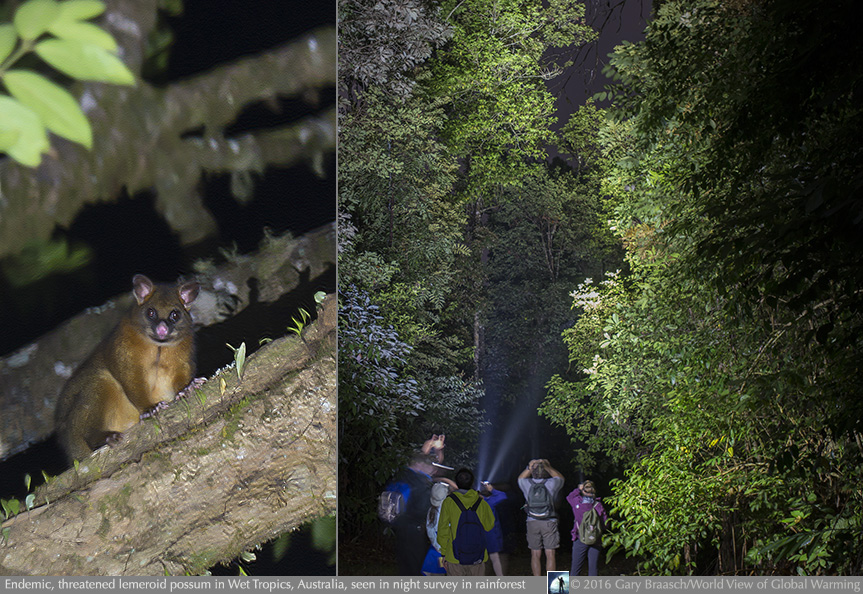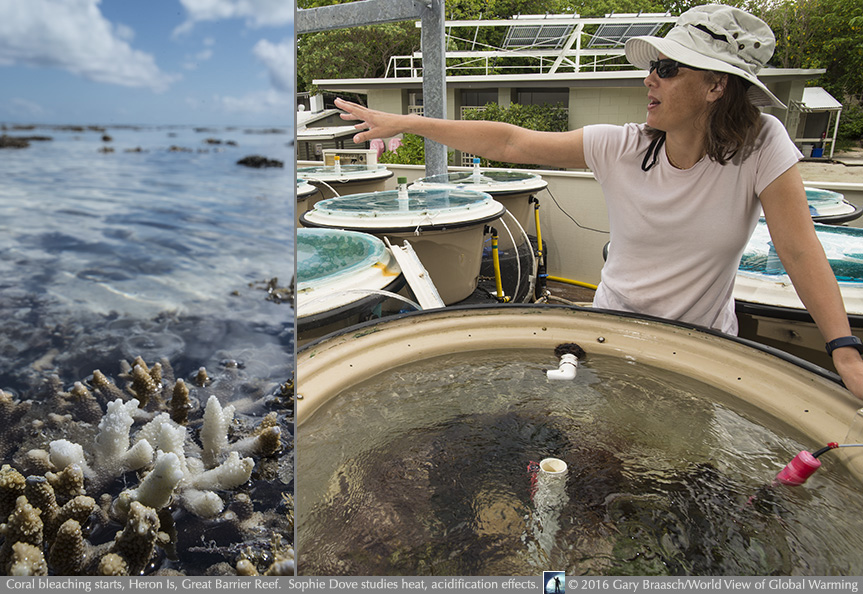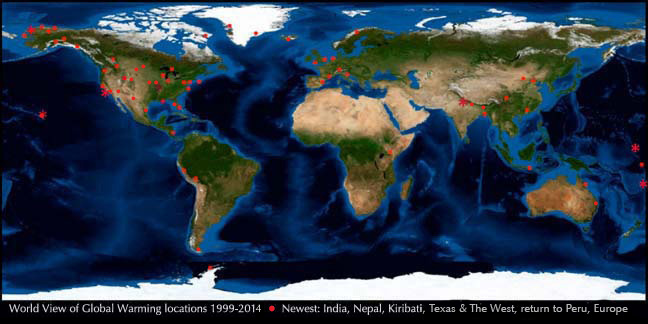Climate Photos of the Week
As Australia suffers under some of the most devastating effects of rapid climate change, scientists find their predictions of threats to World Heritage forests and coral reefs are coming true, inspiring new experiments and programs to help them survive. World View of Global Warming returns to Australia after 10 years — special reports coming up this month.

The alarm first went out in 2003, in what he called “an impending biological catastrophe": Biologist Stephen Williams of James Cook University in Queensland, with his colleagues, was the first to predict that an entire rare ecosystem, the most diverse in Australia with scores of animals and birds found nowhere else, would be pushed toward its physical limits at the top of a tropical mountain range if global warming continued. The paper was a turning point, focusing scientists and policy makers on climate change’s effects on ecosystems worldwide.
Today, still returning yearly to his observing plots in the Wet Tropics World Heritage Area mountains near Cairns to record endemic marsupials, reptiles, amphibians and birds, Williams says many vertebrates “have disappeared in this time“ from lower elevation forests where he first sighted them. Fifty percent of the bird species declined in numbers; ringtail possums, the nocturnal arboreal marsupial mammals that evolved here, “have all moved to higher, cooler elevations. What we predicted 10 years ago would happen is coming true.”
Coming up, Gary Braasch and Joan Rothlein will report on this year’s field research supported by an Earthwatch Expedition, and how Williams and his colleagues are working with policymakers in Australia.

Off shore of the Wet Tropics mountains of Queensland lies the Great Barrier Reef, another World Heritage area being damaged by rapid climate change. As this year’s strong El Nino intensified summer temperatures, “sea surface temperatures are fluctuating across the 345,000 square kilometres of Marine Park,” reported park Chairman Dr. Russell Reichelt, "but in some areas they’ve ranged up to 2.5 degrees above the average for summer.” Scattered bleaching — when corals get too warm and the animals’ symbiosis with a marine algae stops — was reported, but scientists said a forecast weak tropical storm with rain and clouds could protect the Reef from the widespread heat damage that occurred in 1998 and 2002. Dr. Terry Hughes, director of the ARC Centre of Excellence for Coral Reef Studies, said more than 100 researchers would be on the reef documenting its health.
The reef is also increasingly feeling the effects of acidification, as the oceans absorb most of the CO2 being released into the atmosphere by fossil fuel burning and other human activities, upsetting the chemical balance corals and shell-making animals rely on. Scientists are actively measuring how heat and acidification changes the health and growth rates of coral in tank experiments like the work of Dr. Sophie Dove at Heron Island Research Station, where we documented her “time machine” of 12 matched “mini-reefs” in which water is calibrated to past, current and predicted levels of CO2 in the atmosphere. At the same time, Carnegie Institution studies on a nearby coral lagoon showed that acidification is already slowing coral growth, and other scientists are trying to understand which corals resist changes and could be used for restoring damaged reefs.
We will be reporting this month on these efforts to learn much more about how heating and acidification affect coral reef ecosystems, during World View of Global Warming’s return documentation journey to Australia, the first since 2005.
15 years of World View of Global Warming, documenting climate change 1999-2015

This project would be impossible without scientists and observers around the world who have provided hundreds of scientific contacts and papers. See Background, Advisors, and Reference for documentation, funders and major advisors, without whom I could not complete the work.
World View of Global Warming is a project of the Blue Earth Alliance, Seattle Washington, a 501(c)3 tax-exempt organization. The project is supported entirely by donations, grants, and license fees for the photographs. Please see information about how to contribute.
For other information about Gary Braasch's climate change projects and books, please see the books Earth Under Fire and How We Know What We Know About Our Changing Climate, and the exhibit "Climate Change in Our World" at the Books and Exhibits link on the top menu of this page.
COPYRIGHT NOTICE:
Photography and text Copyright © 2005 - 2017 (and before) Gary Braasch All rights reserved. Use of photographs in any manner without permission is prohibited by US copyright law. Photography is available for license to publications and other uses. Please contact requestinformation@worldviewofglobalwarming.org. View more of Gary Braasch's photography here.



